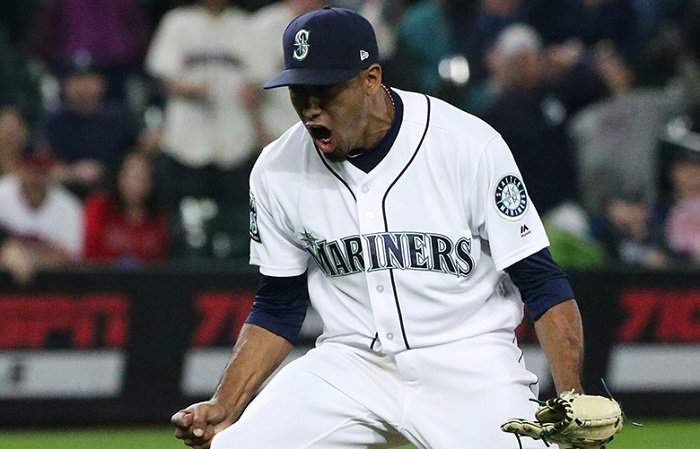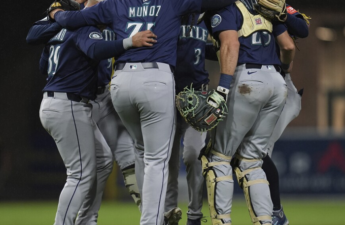There’s a lot going on in my life right now. I just moved across the country and it was every bit as arduous and joyous as that sounds. In less than a week, I go back to school for the first time in sixteen years. This may have something to do with the three-hour facelift I just gave this website (refresh if you’re not seeing new colors, images, and design of all kinds). I’m going to talk about all that. But not tonight.

Tonight, I want to talk about Edwin Diaz. Consider this my personal memo to Manager Scott Servais, who with the exception of what I’m about to discuss and ever pitching Juan Nicasio in any situation, has done close to a perfect job with this year’s Mariners, the biggest surprise in Major League Baseball this season so far. They have the fourth best record in baseball – better than anyone in the National League – despite being expected to be mediocre. It’s pretty much the story any time the M’s are good. They were expected to be bad and they aren’t and that’s wonderful for the city of Seattle and its far-flung fans like me.
Edwin Diaz is the best closer in baseball, at least in terms of making good on the extraordinary number of games he’s been asked to close out, to save. A quirk of the Mariners’ season is that they are in a colossal number of one-run games (40) and they win a vast proportion of them (27/40). They just completed their 101st game last night, so almost two-fifths of their games are one-run affairs and more than a quarter of their wins are one-run wins. This is highly unusual and would be considered a fluke if it weren’t for a lot of clutch late-inning hitting and the skill of Edwin Diaz, who is often asked to come in and get three outs without surrendering a run. He has 38 saves in 41 opportunities this year, by far the best in the Majors.
Diaz has been asked to enter two situations this year. Games where the Mariners have the lead and games where the Mariners are tied.
There’s a lot of conventional wisdom out there about bringing in your team’s closer in the top of the 9th of a tied ballgame at home. In a home game, if you hit the 9th inning tied, there cannot be a save situation. If you win, it will be a walk-off win, a game-ender, because baseball, almost uniquely in sports, only lasts while both teams have a chance of winning. So conventional wisdom says that your closer is wasted in such a game but is the best candidate to pitch the top of the 9th and give your team a chance to walk-off in the bottom of the frame.
Conventional wisdom is wrong. At least when it comes to Edwin Diaz.
Overall this year, Diaz has an 0-3 record with 38 saves and 3 blown saves. The Mariners are 48-3 when he pitches. He has a 2.12 ERA over 51 innings.
But in tied games, Diaz has an 0-3 record with no saves or blown saves. The Mariners are 2-3 when he pitches in ties. He has a 10.38 ERA over 4 1/3 innings.
In games where the Mariners lead, Diaz has 38 saves and 3 blown saves. The Mariners are 46-0 when he pitches with the lead. He has a 1.35 ERA over 46 2/3 innings.
Again, for those in the back:
1.35 ERA in 46 2/3 innings vs. 10.38 ERA over 4 1/3 innings.
Five appearances, all in ties, are responsible for nearly half of his earned runs allowed (5/12). He has one unearned run given up this year, also in a tie. He’s only given up two homers all season. Yup, one of them was in a tie.
I know there are those of you who would say this is a small sample size. But the Mariners are more likely to lose than not if Diaz pitches in a tie. This for a team that’s 27-13 in one-run games, somehow undefeated in extra innings (8-0), and forty-six and oh when he pitches with the lead.
In case you think this isn’t about Eddie’s mentality, let’s cut away the few times he’s come in with a big lead, not a save situation:
In non-save leads, Diaz has no record. He has a 3.60 ERA over 5 innings. The M’s are 5-0 here.
In save situations, Diaz has 38 save and 3 blown saves. He has a 1.08 ERA over 41 2/3 innings. The M’s are 41-0 here, winning all 3 of his blown saves.
Obviously, there’s no real impact on the record with the differing lead situations, but let’s review again:
Ties: 10.38 ERA, plus an unearned run
Non-Save Leads: 3.60 ERA
Save Situations: 1.08 ERA
It’s trendy these days for so-called sabermetricians to rule the baseball world, declaring that players are robots who will perform to a numerical average commensurate with their ability night in and night out, regardless of circumstances. These folks believe that variance is mere probability splayed out over time, that talent will out, that whether a player’s father just died or they were just snubbed for the All-Star Game or whether they’re battling flu or insomnia makes no difference whatsoever in their performance. The mind, these folks say, is so divorced from the athlete’s body as to be irrelevant.
Scott Servais, sabermetricians, baseball fans near and far, I give you Edwin Diaz as my rebuttal. The man is not only pitching with exceptional talent under enormous pressure night after night, but he is feeding off that pressure. He needs it. That pressure is the source of his skill. And he lives to come in and shut things down, to be necessary. However abstractly necessary he may be in a tied game, he knows he will not be able to pound the mitt at the end, scream, and shut the door. Holding a tie offers none of the same benefits of a save and it causes Edwin Diaz to fall apart. Again, the Mariners are 48-3 when Diaz pitches but just 2-3 when he pitches in ties.
Scott, stop bringing Edwin Diaz into ties. Please. They’re not good for him. I’m fine if you keep bringing him in with whatever big leads we have because, really, no harm done, though it’s probably a waste when he is trying to get saves most every other night. But for the love of all that is good in Seattle baseball, no more Diaz in ties.
Other than that, designate Nicasio for assignment, and keep up the good work!


